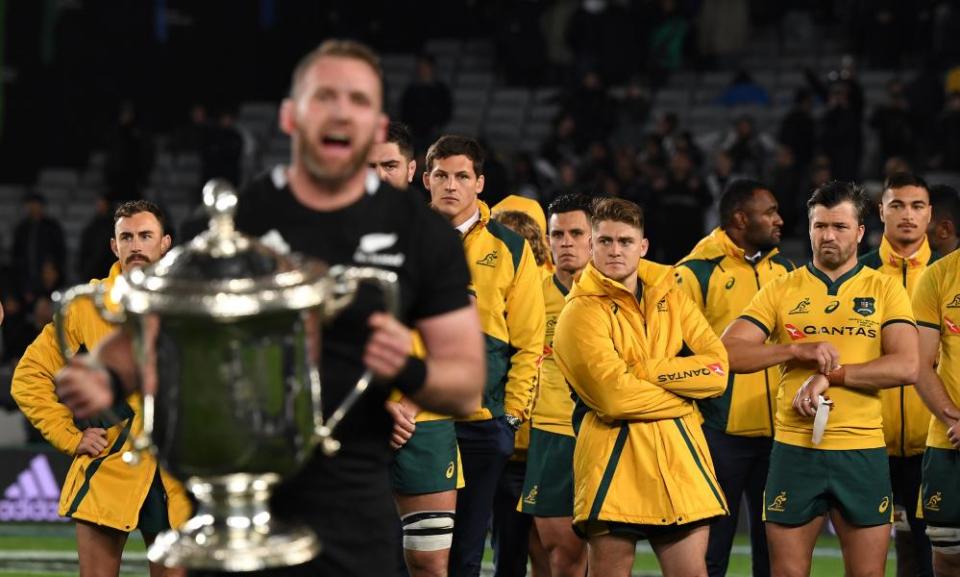Who will blink first in Australia's rugby standoff with New Zealand?

With an impasse reached over a future trans-Tasman Super Rugby competition after New Zealand’s invitation for expressions of interest prompted an angry reaction from Australia, the resolution of the issue may come down to who blinks first.
There is potentially room for just two or three of Australia’s five Super Rugby franchises in a new eight to 10 team competition. But what happens now if both countries stand firm? Who has the most to gain and who has the most to lose if neither give an inch?
Related: Australian rugby faces further fracture as New Zealand plan prompts fight for survival
New Zealand’s domestic Super Rugby Aotearoa competition is going gang-busters, providing high-quality rugby, which is attracting big crowds and television audiences. Yet, New Zealand has admitted the five-team competition is unsustainable long-term; the Kiwis need at least eight teams to ensure the competition is commercially viable.
They have the option of strengthening their domestic 14-team National Provincial Championship with All Blacks and Super Rugby players in a high-quality, stand-alone competition, something Australia does not have. The NPC was once the major domestic competition in New Zealand and there is a great deal of history and tribalism associated with it, but it has struggled financially since the advent of Super Rugby in 1996.
Some New Zealanders believe they would be better off re-invigorating the NPC than reluctantly accepting Australia’s demand for five teams. But the problem of going down this path is that Kiwi broadcaster Sky Sports apparently does not support it, preferring to focus on the world renowned Super Rugby brands such as the Crusaders and the Blues.
Perhaps this explains speculation that New Zealand is becoming more amenable to Australia’s position, but that does not necessarily mean the Kiwis are prepared to give Australia everything it wants.
New Zealand does not want five Australian teams in the competition because the Kiwis believe Australia lacks sufficient playing depth to carry that many competitive sides. The difference in standard between Super Rugby Aotearoa and Super Rugby AU is stark. The comparatively low quality of games between the Rebels and Waratahs and the Brumbies and Western Force over the weekend was not a good argument for five Australian teams.
In the absence of any other foreign teams such as those from the Pacific Islands, Japan or Argentina, New Zealand would need at least three Australian sides to create an eight-team trans-Tasman competition and that is probably as many as the Kiwis would want.
But Australian rugby does not want to go through the pain of axing a team again after the agony it went through with the Western Force in 2017. Ironically, the Force would still be in the Super Rugby wilderness if not for the financial support of mining magnate Andrew “Twiggy” Forrest and the coronavirus pandemic. RA needed to bring the Force back into the fold to create a five-team domestic competition after the coronavirus pandemic forced the shutdown of the multi-national Super Rugby competition in March.
It seems almost certain the Force will be included in any future Super Rugby competition whether there are five Australian teams or not, which complicates the situation somewhat.
Australia and New Zealand could reach a compromise and create a nine-team competition with five Kiwi sides and four Australian franchises, leaving a 10th vacancy to be filled at a later date. There have been questions raised over the future of the Melbourne Rebels, although the 2011 expansion franchise appears to remain as part of RA’s plans.
While Australia does not have the stomach to cut another team, what is the alternative? If Australia decided to go it alone, it would struggle to create a high-standard domestic competition, which would have huge repercussions for the game. Australia’s four teams could always joining the Force in Forrest’s Global Rapid Rugby, but that would not generate lucrative broadcast revenue or achieve high-performance objectives to prepare Wallabies for Test rugby.
Related: The Breakdown | New Zealand establishes its rugby superiority in battle with Australia
One of the reasons Australia is not budging on five teams is the argument the Australian sides need more home games to be economically viable. But if Australia’s talent is spread too thinly and the standard of play is mediocre disenchanted fans will not attend games anyway, no matter how many home matches are in the schedule.
A 10-team trans-Tasman competition would inevitably result in a two-tiered competition with five New Zealand teams on top of the table and five Australian teams on the bottom and that would be a disaster for Australia.
As current England and former Wallabies coach Eddie Jones has pointed out, crowds want to see the best against the best and that unfortunately means reducing the number of Australian teams, although perhaps not as many as New Zealand would wish for. But time is running out and at some point both nations may need to find a commonsense solution or they could both end up losers, regardless of who blinks first.

 Yahoo Sports
Yahoo Sports 